Strategic Analysis: Virgin Australia Airlines using Five Forces
VerifiedAdded on 2022/10/01
|6
|1486
|18
Report
AI Summary
This report provides a strategic analysis of Virgin Australia Airlines Holdings Limited using Porter's Five Forces model. The introduction highlights the importance of macro-environmental analysis and sustainable practices in the airline industry. The core of the report applies Porter's Five Forces to evaluate the competitive landscape, including the threats of new entrants, the bargaining power of suppliers and buyers, the threats of substitutes, and the rivalry among existing competitors. Each force is examined in detail, with specific examples related to Virgin Australia. The report also discusses the usefulness and limitations of the model, recommending the integration of Porter's Five Forces with other strategic tools for a comprehensive understanding of the external environment. The conclusion emphasizes the value of this analysis in shaping Virgin Australia's future strategies and promoting its performance by improving services and adapting to emerging issues. References to relevant academic articles are also included.
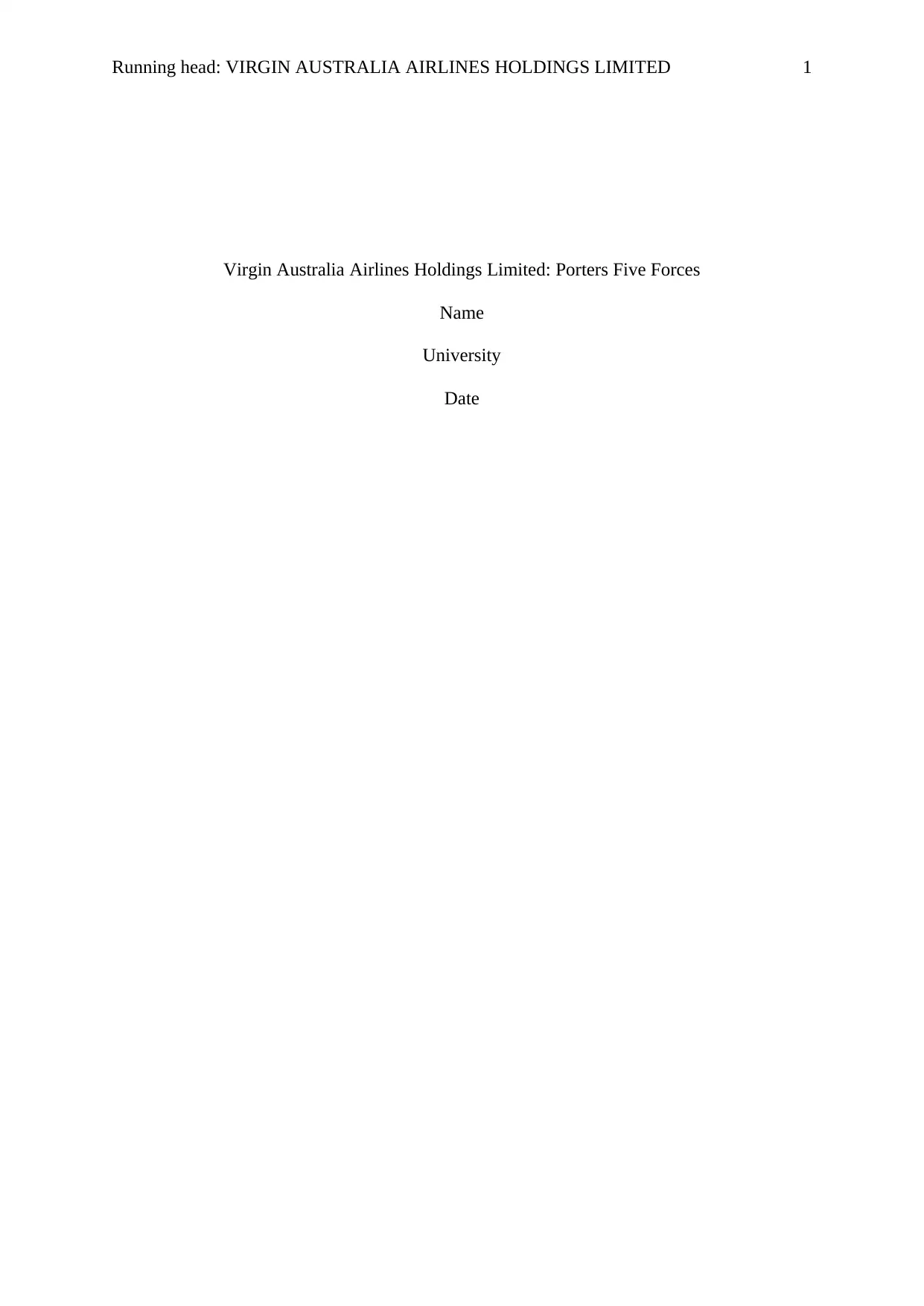
Running head: VIRGIN AUSTRALIA AIRLINES HOLDINGS LIMITED 1
Virgin Australia Airlines Holdings Limited: Porters Five Forces
Name
University
Date
Virgin Australia Airlines Holdings Limited: Porters Five Forces
Name
University
Date
Paraphrase This Document
Need a fresh take? Get an instant paraphrase of this document with our AI Paraphraser
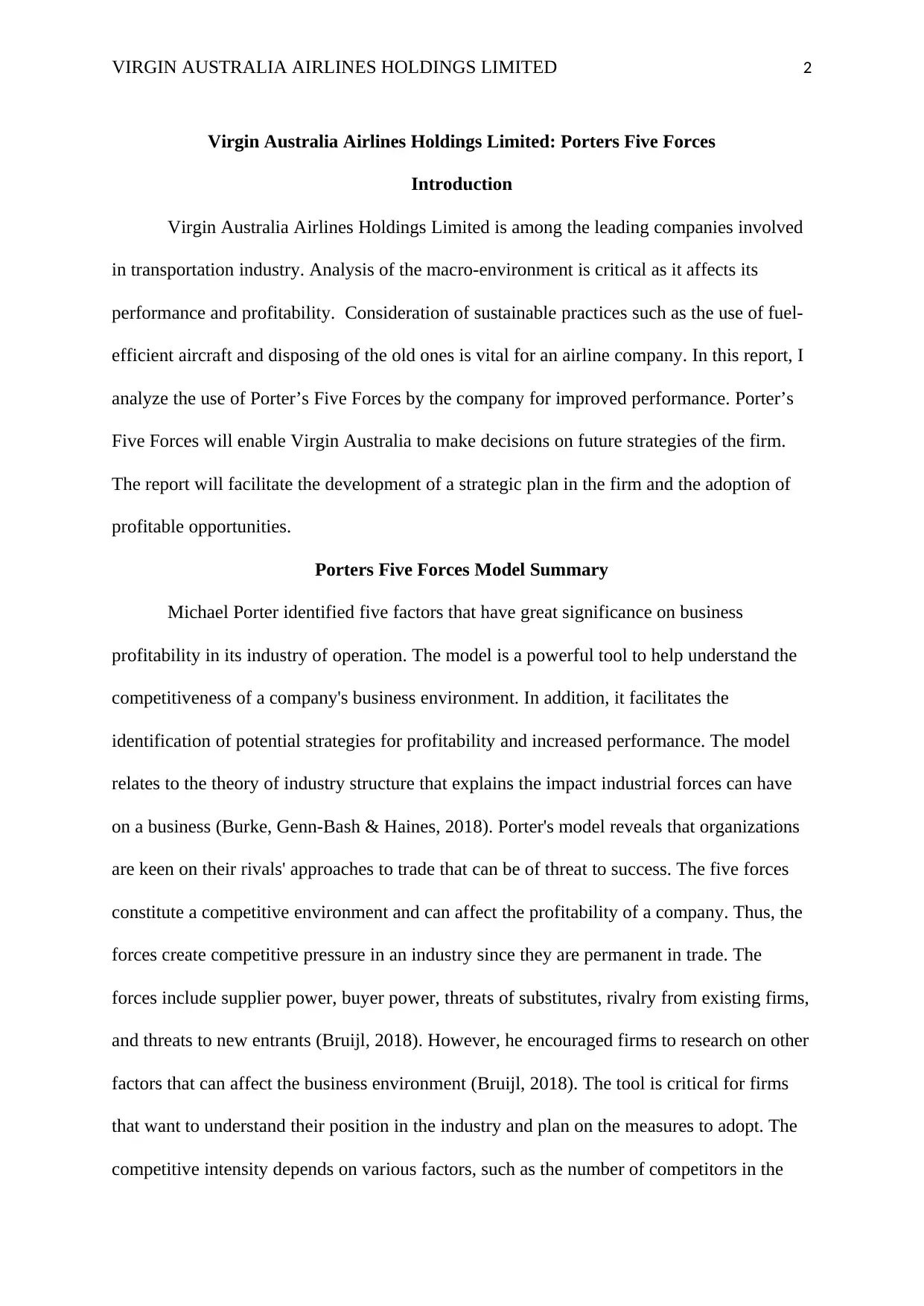
VIRGIN AUSTRALIA AIRLINES HOLDINGS LIMITED 2
Virgin Australia Airlines Holdings Limited: Porters Five Forces
Introduction
Virgin Australia Airlines Holdings Limited is among the leading companies involved
in transportation industry. Analysis of the macro-environment is critical as it affects its
performance and profitability. Consideration of sustainable practices such as the use of fuel-
efficient aircraft and disposing of the old ones is vital for an airline company. In this report, I
analyze the use of Porter’s Five Forces by the company for improved performance. Porter’s
Five Forces will enable Virgin Australia to make decisions on future strategies of the firm.
The report will facilitate the development of a strategic plan in the firm and the adoption of
profitable opportunities.
Porters Five Forces Model Summary
Michael Porter identified five factors that have great significance on business
profitability in its industry of operation. The model is a powerful tool to help understand the
competitiveness of a company's business environment. In addition, it facilitates the
identification of potential strategies for profitability and increased performance. The model
relates to the theory of industry structure that explains the impact industrial forces can have
on a business (Burke, Genn-Bash & Haines, 2018). Porter's model reveals that organizations
are keen on their rivals' approaches to trade that can be of threat to success. The five forces
constitute a competitive environment and can affect the profitability of a company. Thus, the
forces create competitive pressure in an industry since they are permanent in trade. The
forces include supplier power, buyer power, threats of substitutes, rivalry from existing firms,
and threats to new entrants (Bruijl, 2018). However, he encouraged firms to research on other
factors that can affect the business environment (Bruijl, 2018). The tool is critical for firms
that want to understand their position in the industry and plan on the measures to adopt. The
competitive intensity depends on various factors, such as the number of competitors in the
Virgin Australia Airlines Holdings Limited: Porters Five Forces
Introduction
Virgin Australia Airlines Holdings Limited is among the leading companies involved
in transportation industry. Analysis of the macro-environment is critical as it affects its
performance and profitability. Consideration of sustainable practices such as the use of fuel-
efficient aircraft and disposing of the old ones is vital for an airline company. In this report, I
analyze the use of Porter’s Five Forces by the company for improved performance. Porter’s
Five Forces will enable Virgin Australia to make decisions on future strategies of the firm.
The report will facilitate the development of a strategic plan in the firm and the adoption of
profitable opportunities.
Porters Five Forces Model Summary
Michael Porter identified five factors that have great significance on business
profitability in its industry of operation. The model is a powerful tool to help understand the
competitiveness of a company's business environment. In addition, it facilitates the
identification of potential strategies for profitability and increased performance. The model
relates to the theory of industry structure that explains the impact industrial forces can have
on a business (Burke, Genn-Bash & Haines, 2018). Porter's model reveals that organizations
are keen on their rivals' approaches to trade that can be of threat to success. The five forces
constitute a competitive environment and can affect the profitability of a company. Thus, the
forces create competitive pressure in an industry since they are permanent in trade. The
forces include supplier power, buyer power, threats of substitutes, rivalry from existing firms,
and threats to new entrants (Bruijl, 2018). However, he encouraged firms to research on other
factors that can affect the business environment (Bruijl, 2018). The tool is critical for firms
that want to understand their position in the industry and plan on the measures to adopt. The
competitive intensity depends on various factors, such as the number of competitors in the
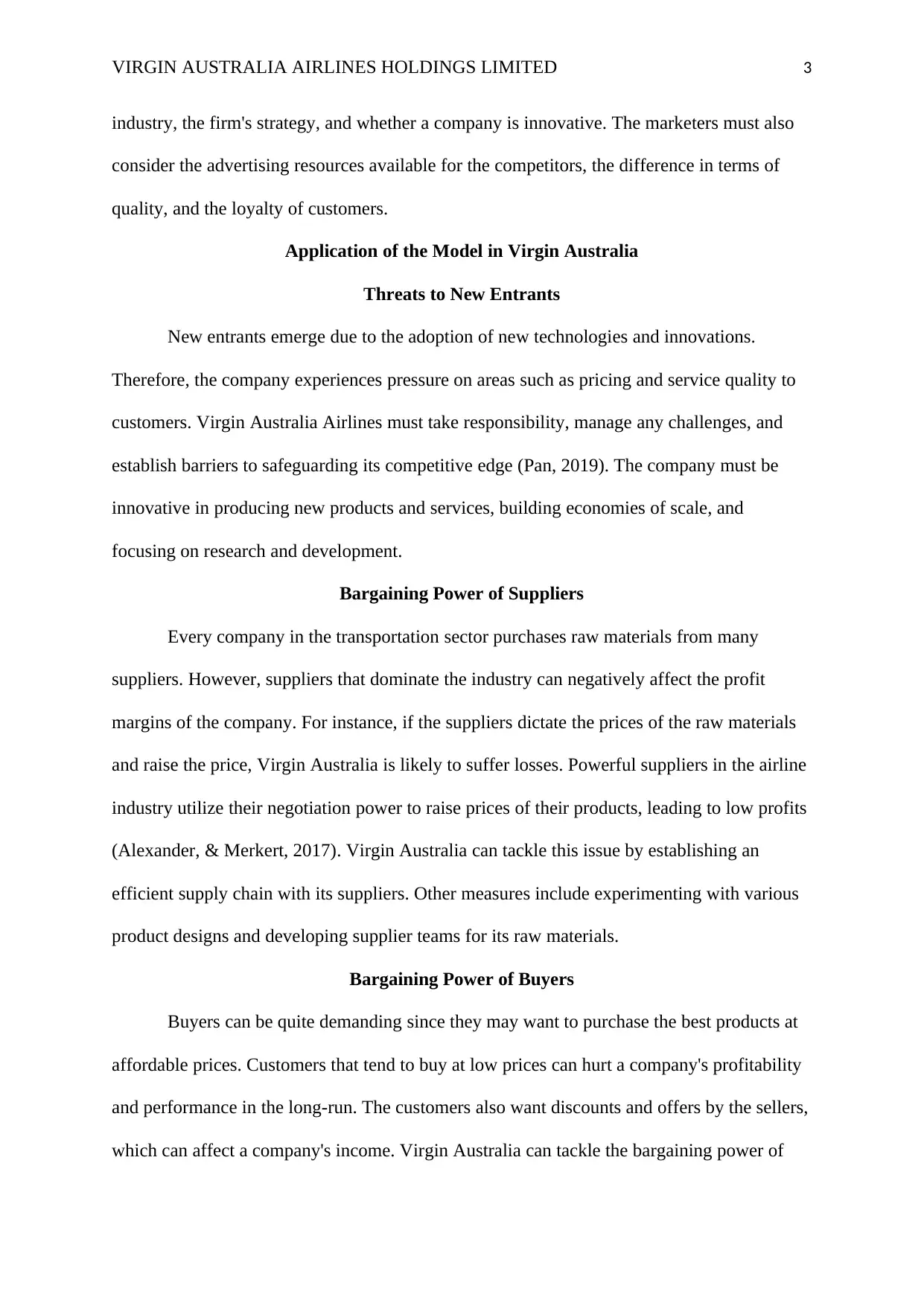
VIRGIN AUSTRALIA AIRLINES HOLDINGS LIMITED 3
industry, the firm's strategy, and whether a company is innovative. The marketers must also
consider the advertising resources available for the competitors, the difference in terms of
quality, and the loyalty of customers.
Application of the Model in Virgin Australia
Threats to New Entrants
New entrants emerge due to the adoption of new technologies and innovations.
Therefore, the company experiences pressure on areas such as pricing and service quality to
customers. Virgin Australia Airlines must take responsibility, manage any challenges, and
establish barriers to safeguarding its competitive edge (Pan, 2019). The company must be
innovative in producing new products and services, building economies of scale, and
focusing on research and development.
Bargaining Power of Suppliers
Every company in the transportation sector purchases raw materials from many
suppliers. However, suppliers that dominate the industry can negatively affect the profit
margins of the company. For instance, if the suppliers dictate the prices of the raw materials
and raise the price, Virgin Australia is likely to suffer losses. Powerful suppliers in the airline
industry utilize their negotiation power to raise prices of their products, leading to low profits
(Alexander, & Merkert, 2017). Virgin Australia can tackle this issue by establishing an
efficient supply chain with its suppliers. Other measures include experimenting with various
product designs and developing supplier teams for its raw materials.
Bargaining Power of Buyers
Buyers can be quite demanding since they may want to purchase the best products at
affordable prices. Customers that tend to buy at low prices can hurt a company's profitability
and performance in the long-run. The customers also want discounts and offers by the sellers,
which can affect a company's income. Virgin Australia can tackle the bargaining power of
industry, the firm's strategy, and whether a company is innovative. The marketers must also
consider the advertising resources available for the competitors, the difference in terms of
quality, and the loyalty of customers.
Application of the Model in Virgin Australia
Threats to New Entrants
New entrants emerge due to the adoption of new technologies and innovations.
Therefore, the company experiences pressure on areas such as pricing and service quality to
customers. Virgin Australia Airlines must take responsibility, manage any challenges, and
establish barriers to safeguarding its competitive edge (Pan, 2019). The company must be
innovative in producing new products and services, building economies of scale, and
focusing on research and development.
Bargaining Power of Suppliers
Every company in the transportation sector purchases raw materials from many
suppliers. However, suppliers that dominate the industry can negatively affect the profit
margins of the company. For instance, if the suppliers dictate the prices of the raw materials
and raise the price, Virgin Australia is likely to suffer losses. Powerful suppliers in the airline
industry utilize their negotiation power to raise prices of their products, leading to low profits
(Alexander, & Merkert, 2017). Virgin Australia can tackle this issue by establishing an
efficient supply chain with its suppliers. Other measures include experimenting with various
product designs and developing supplier teams for its raw materials.
Bargaining Power of Buyers
Buyers can be quite demanding since they may want to purchase the best products at
affordable prices. Customers that tend to buy at low prices can hurt a company's profitability
and performance in the long-run. The customers also want discounts and offers by the sellers,
which can affect a company's income. Virgin Australia can tackle the bargaining power of
⊘ This is a preview!⊘
Do you want full access?
Subscribe today to unlock all pages.

Trusted by 1+ million students worldwide
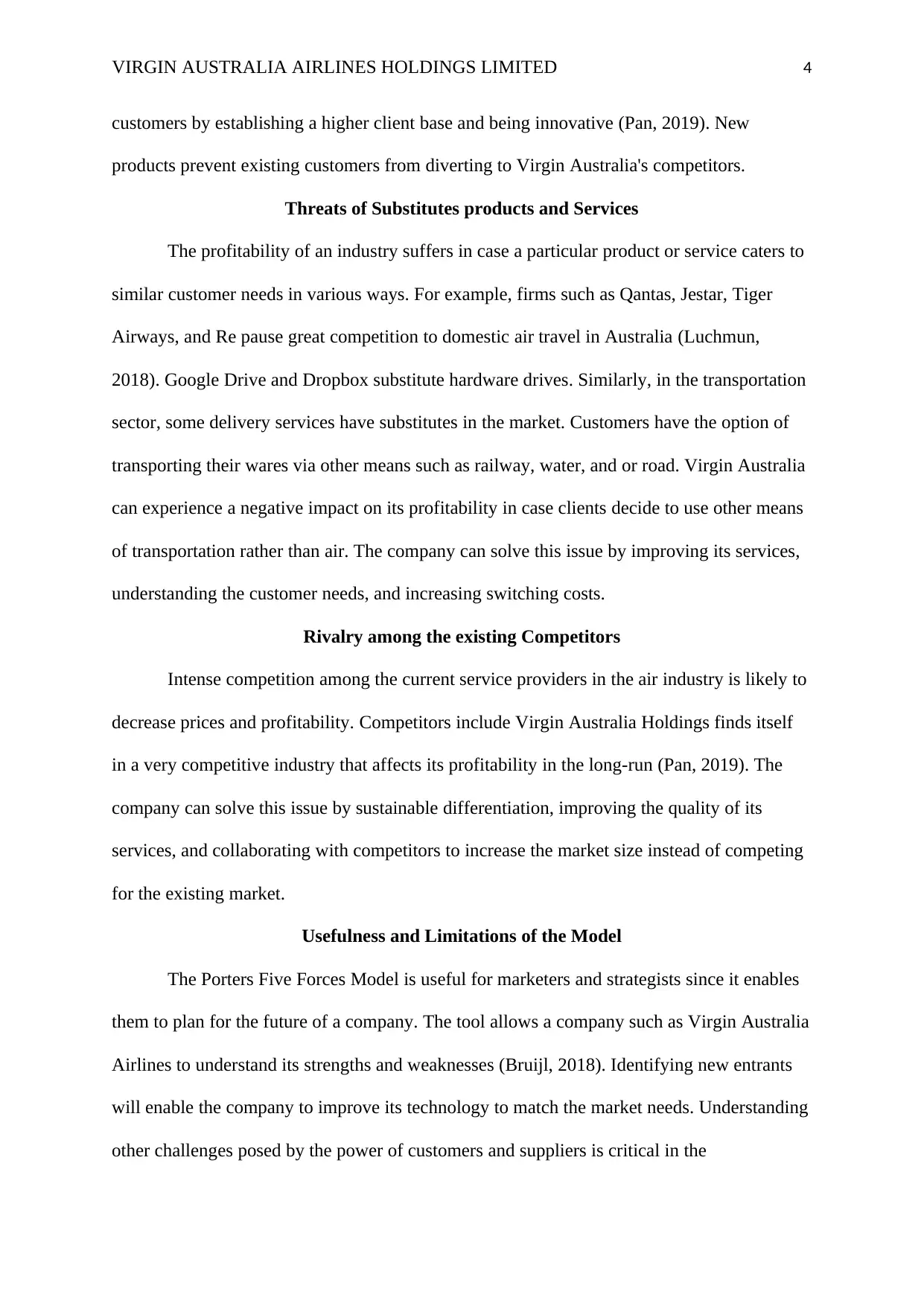
VIRGIN AUSTRALIA AIRLINES HOLDINGS LIMITED 4
customers by establishing a higher client base and being innovative (Pan, 2019). New
products prevent existing customers from diverting to Virgin Australia's competitors.
Threats of Substitutes products and Services
The profitability of an industry suffers in case a particular product or service caters to
similar customer needs in various ways. For example, firms such as Qantas, Jestar, Tiger
Airways, and Re pause great competition to domestic air travel in Australia (Luchmun,
2018). Google Drive and Dropbox substitute hardware drives. Similarly, in the transportation
sector, some delivery services have substitutes in the market. Customers have the option of
transporting their wares via other means such as railway, water, and or road. Virgin Australia
can experience a negative impact on its profitability in case clients decide to use other means
of transportation rather than air. The company can solve this issue by improving its services,
understanding the customer needs, and increasing switching costs.
Rivalry among the existing Competitors
Intense competition among the current service providers in the air industry is likely to
decrease prices and profitability. Competitors include Virgin Australia Holdings finds itself
in a very competitive industry that affects its profitability in the long-run (Pan, 2019). The
company can solve this issue by sustainable differentiation, improving the quality of its
services, and collaborating with competitors to increase the market size instead of competing
for the existing market.
Usefulness and Limitations of the Model
The Porters Five Forces Model is useful for marketers and strategists since it enables
them to plan for the future of a company. The tool allows a company such as Virgin Australia
Airlines to understand its strengths and weaknesses (Bruijl, 2018). Identifying new entrants
will enable the company to improve its technology to match the market needs. Understanding
other challenges posed by the power of customers and suppliers is critical in the
customers by establishing a higher client base and being innovative (Pan, 2019). New
products prevent existing customers from diverting to Virgin Australia's competitors.
Threats of Substitutes products and Services
The profitability of an industry suffers in case a particular product or service caters to
similar customer needs in various ways. For example, firms such as Qantas, Jestar, Tiger
Airways, and Re pause great competition to domestic air travel in Australia (Luchmun,
2018). Google Drive and Dropbox substitute hardware drives. Similarly, in the transportation
sector, some delivery services have substitutes in the market. Customers have the option of
transporting their wares via other means such as railway, water, and or road. Virgin Australia
can experience a negative impact on its profitability in case clients decide to use other means
of transportation rather than air. The company can solve this issue by improving its services,
understanding the customer needs, and increasing switching costs.
Rivalry among the existing Competitors
Intense competition among the current service providers in the air industry is likely to
decrease prices and profitability. Competitors include Virgin Australia Holdings finds itself
in a very competitive industry that affects its profitability in the long-run (Pan, 2019). The
company can solve this issue by sustainable differentiation, improving the quality of its
services, and collaborating with competitors to increase the market size instead of competing
for the existing market.
Usefulness and Limitations of the Model
The Porters Five Forces Model is useful for marketers and strategists since it enables
them to plan for the future of a company. The tool allows a company such as Virgin Australia
Airlines to understand its strengths and weaknesses (Bruijl, 2018). Identifying new entrants
will enable the company to improve its technology to match the market needs. Understanding
other challenges posed by the power of customers and suppliers is critical in the
Paraphrase This Document
Need a fresh take? Get an instant paraphrase of this document with our AI Paraphraser
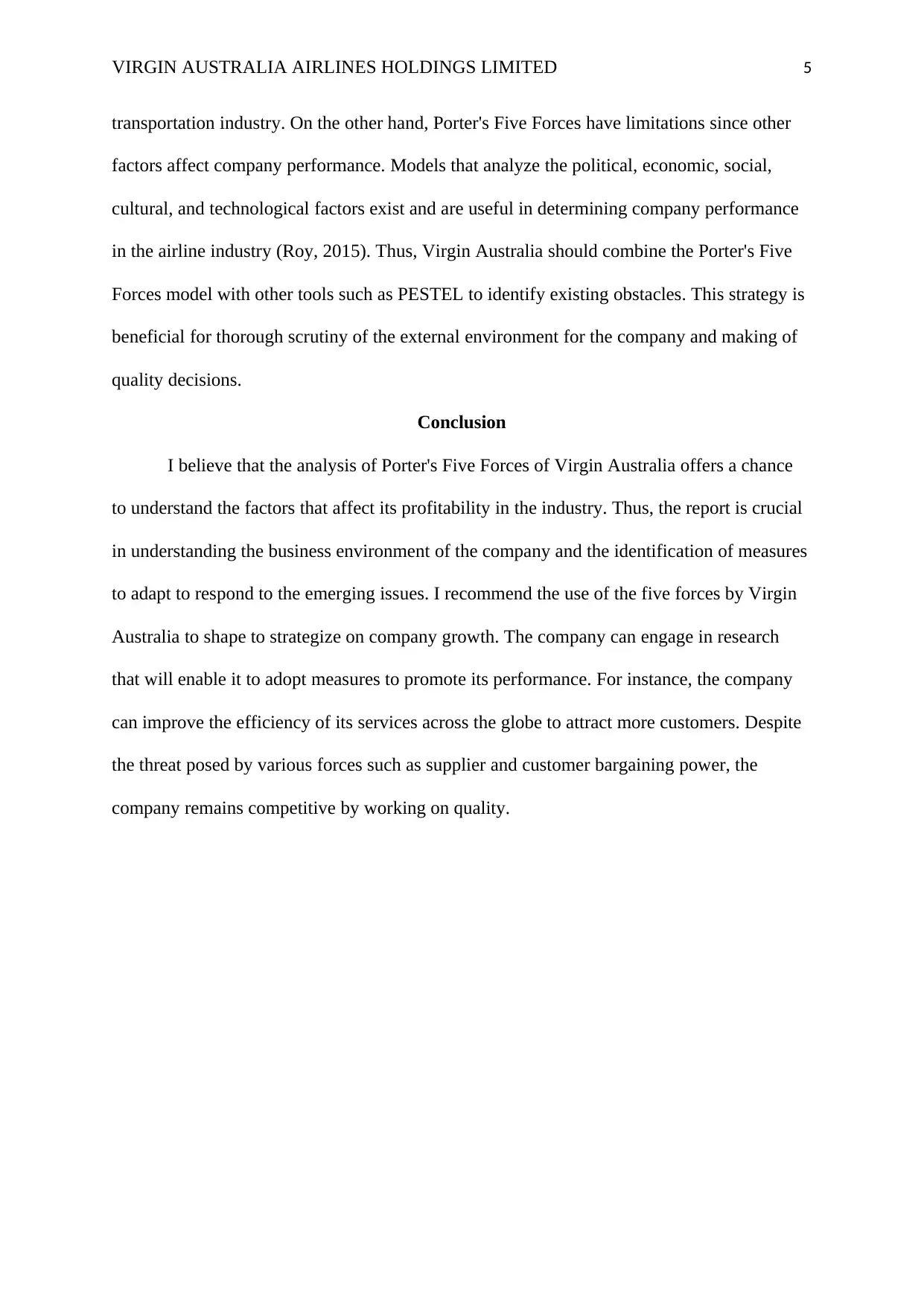
VIRGIN AUSTRALIA AIRLINES HOLDINGS LIMITED 5
transportation industry. On the other hand, Porter's Five Forces have limitations since other
factors affect company performance. Models that analyze the political, economic, social,
cultural, and technological factors exist and are useful in determining company performance
in the airline industry (Roy, 2015). Thus, Virgin Australia should combine the Porter's Five
Forces model with other tools such as PESTEL to identify existing obstacles. This strategy is
beneficial for thorough scrutiny of the external environment for the company and making of
quality decisions.
Conclusion
I believe that the analysis of Porter's Five Forces of Virgin Australia offers a chance
to understand the factors that affect its profitability in the industry. Thus, the report is crucial
in understanding the business environment of the company and the identification of measures
to adapt to respond to the emerging issues. I recommend the use of the five forces by Virgin
Australia to shape to strategize on company growth. The company can engage in research
that will enable it to adopt measures to promote its performance. For instance, the company
can improve the efficiency of its services across the globe to attract more customers. Despite
the threat posed by various forces such as supplier and customer bargaining power, the
company remains competitive by working on quality.
transportation industry. On the other hand, Porter's Five Forces have limitations since other
factors affect company performance. Models that analyze the political, economic, social,
cultural, and technological factors exist and are useful in determining company performance
in the airline industry (Roy, 2015). Thus, Virgin Australia should combine the Porter's Five
Forces model with other tools such as PESTEL to identify existing obstacles. This strategy is
beneficial for thorough scrutiny of the external environment for the company and making of
quality decisions.
Conclusion
I believe that the analysis of Porter's Five Forces of Virgin Australia offers a chance
to understand the factors that affect its profitability in the industry. Thus, the report is crucial
in understanding the business environment of the company and the identification of measures
to adapt to respond to the emerging issues. I recommend the use of the five forces by Virgin
Australia to shape to strategize on company growth. The company can engage in research
that will enable it to adopt measures to promote its performance. For instance, the company
can improve the efficiency of its services across the globe to attract more customers. Despite
the threat posed by various forces such as supplier and customer bargaining power, the
company remains competitive by working on quality.
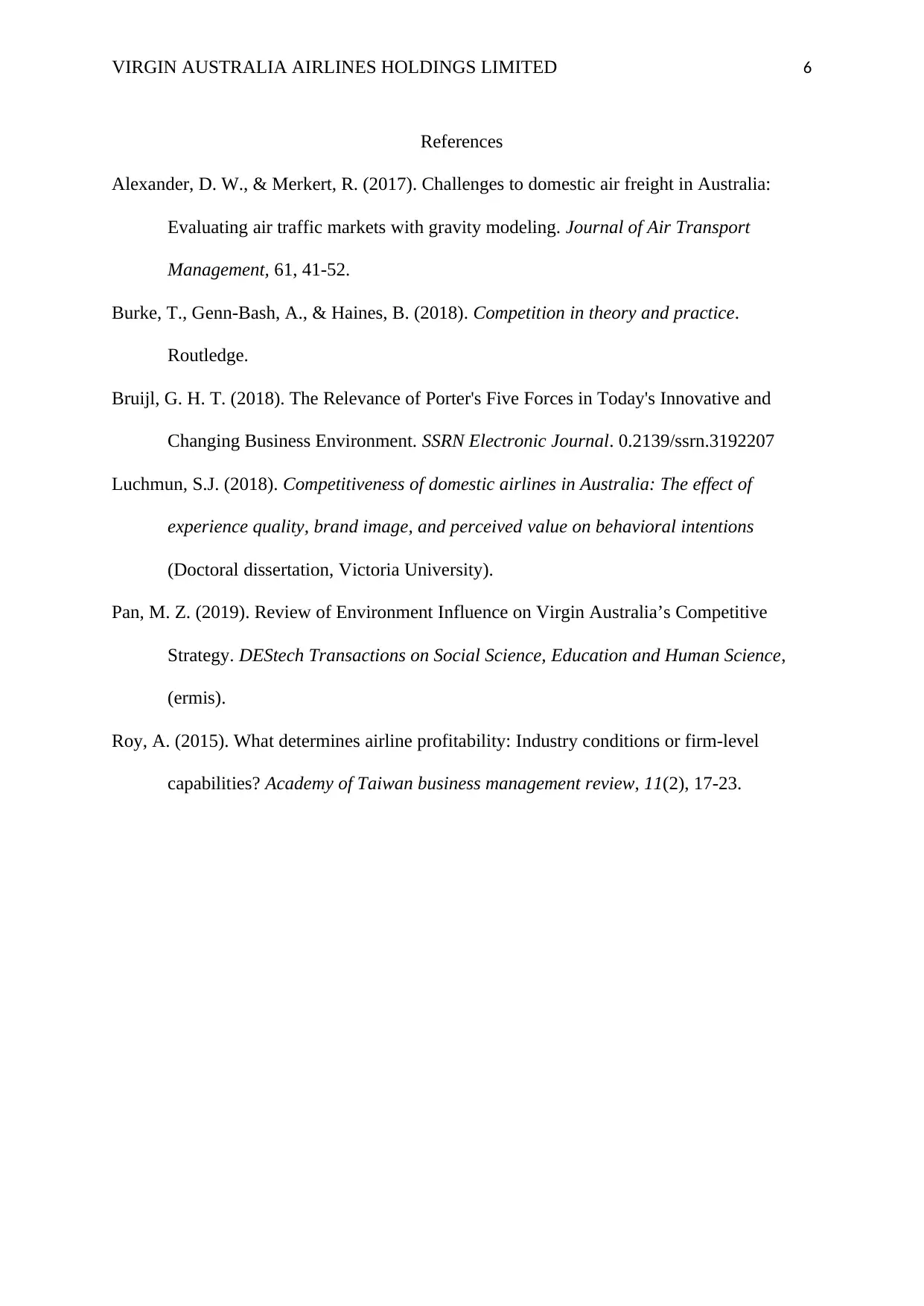
VIRGIN AUSTRALIA AIRLINES HOLDINGS LIMITED 6
References
Alexander, D. W., & Merkert, R. (2017). Challenges to domestic air freight in Australia:
Evaluating air traffic markets with gravity modeling. Journal of Air Transport
Management, 61, 41-52.
Burke, T., Genn-Bash, A., & Haines, B. (2018). Competition in theory and practice.
Routledge.
Bruijl, G. H. T. (2018). The Relevance of Porter's Five Forces in Today's Innovative and
Changing Business Environment. SSRN Electronic Journal. 0.2139/ssrn.3192207
Luchmun, S.J. (2018). Competitiveness of domestic airlines in Australia: The effect of
experience quality, brand image, and perceived value on behavioral intentions
(Doctoral dissertation, Victoria University).
Pan, M. Z. (2019). Review of Environment Influence on Virgin Australia’s Competitive
Strategy. DEStech Transactions on Social Science, Education and Human Science,
(ermis).
Roy, A. (2015). What determines airline profitability: Industry conditions or firm-level
capabilities? Academy of Taiwan business management review, 11(2), 17-23.
References
Alexander, D. W., & Merkert, R. (2017). Challenges to domestic air freight in Australia:
Evaluating air traffic markets with gravity modeling. Journal of Air Transport
Management, 61, 41-52.
Burke, T., Genn-Bash, A., & Haines, B. (2018). Competition in theory and practice.
Routledge.
Bruijl, G. H. T. (2018). The Relevance of Porter's Five Forces in Today's Innovative and
Changing Business Environment. SSRN Electronic Journal. 0.2139/ssrn.3192207
Luchmun, S.J. (2018). Competitiveness of domestic airlines in Australia: The effect of
experience quality, brand image, and perceived value on behavioral intentions
(Doctoral dissertation, Victoria University).
Pan, M. Z. (2019). Review of Environment Influence on Virgin Australia’s Competitive
Strategy. DEStech Transactions on Social Science, Education and Human Science,
(ermis).
Roy, A. (2015). What determines airline profitability: Industry conditions or firm-level
capabilities? Academy of Taiwan business management review, 11(2), 17-23.
⊘ This is a preview!⊘
Do you want full access?
Subscribe today to unlock all pages.

Trusted by 1+ million students worldwide
1 out of 6
Related Documents
Your All-in-One AI-Powered Toolkit for Academic Success.
+13062052269
info@desklib.com
Available 24*7 on WhatsApp / Email
![[object Object]](/_next/static/media/star-bottom.7253800d.svg)
Unlock your academic potential
Copyright © 2020–2025 A2Z Services. All Rights Reserved. Developed and managed by ZUCOL.





